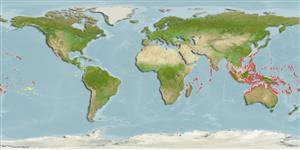Preferred temperature (Ref.
123201): 25.2 - 29.3, mean 28.4 °C (based on 2871 cells).
Phylogenetic diversity index (Ref.
82804): PD
50 = 0.5312 [Uniqueness, from 0.5 = low to 2.0 = high].
Bayesian length-weight: a=0.01950 (0.01214 - 0.03132), b=2.94 (2.80 - 3.08), in cm total length, based on LWR estimates for this species & (Sub)family-body (Ref.
93245).
ระดับชั้นอาหาร (Ref.
69278): 4.0 ±0.59 se; based on food items.
ความสามารถในการกลับคืนสู่ปกติ (Ref.
120179): ความสูง, เวลาต่ำสุดที่จะทำให้ประชากรเพิ่มขึ้นเป็น 2 เท่าใช้เวลาน้อยกว่า 15 เดือน (Preliminary K or Fecundity.).
Fishing Vulnerability (Ref.
59153): Low vulnerability (14 of 100).
Nutrients (Ref.
124155): Calcium = 68.7 [31.1, 214.1] mg/100g; Iron = 0.693 [0.278, 1.457] mg/100g; Protein = 18.8 [17.6, 20.0] %; Omega3 = 0.159 [0.065, 0.380] g/100g; Selenium = 27.1 [15.3, 53.9] μg/100g; VitaminA = 82.9 [30.7, 235.8] μg/100g; Zinc = 1.27 [0.81, 1.98] mg/100g (wet weight);
